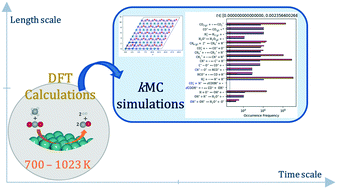Kinetic Monte Carlo simulations of the dry reforming of methane catalyzed by the Ru (0001) surface based on density functional theory calculations†
Abstract
We combined first-principles calculations with kinetic Monte Carlo (kMC) simulations to study the dry reforming of methane catalyzed by the Ru (0001) surface. We considered adsorption/desorption reactions and a total number of 36 elementary steps with all rates obtained from periodic density functional theory (DFT)-based calculations. Our DFT results suggest that the CO2 cleavage occurs directly, leading to CO* and O*. The CO2 dissociation also has a lower energy barrier than the CH4 activation, while subsequent C–H activations leading to CH*/C* are easier than methane's first C–H cleavage. The O* produced by CO2 dissociation is the oxidant of C/CH* intermediates, leading to the formation of a second CO molecule. Graph-theoretical kinetic Monte Carlo simulations were subsequently carried out at different partial pressures and temperatures over 5 × 5 hexagonal periodic lattices considering various adsorption sites. In contrast to the DFT results, the kinetic Monte Carlo simulations suggest that the DRM reaction proceeds predominantly through the direct C* + O* route, with minor participation of the CH* + O* step. kMC simulations at different temperatures suggest an Arrhenius behavior for the catalytic system. We obtain an apparent activation energy of 78 kJ mol−1 within 700–800 K and at low pressure (0.32 kPa). Conversely, under typical conditions of dry reforming of methane (within 800–1023 K and at a total pressure of 100 kPa), we calculated an apparent activation energy equal to 158 kJ mol−1. Increasing the temperature also increases the calculated turnover frequency of the system and changes the coverage of species present on the catalytic surface. The inclusion of a pairwise O–O interaction is needed at the low pressure/temperature regime to avoid surface poisoning. The C–C interaction is also included at high pressures and temperatures since C* accumulates on the surface otherwise.

- This article is part of the themed collection: Emerging Investigator Series


 Please wait while we load your content...
Please wait while we load your content...